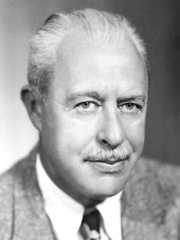
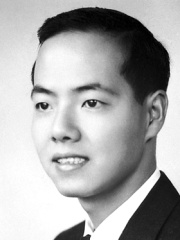
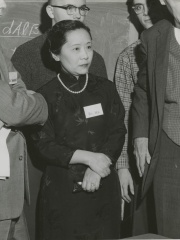
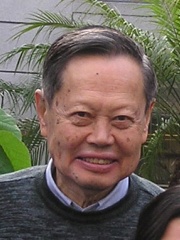
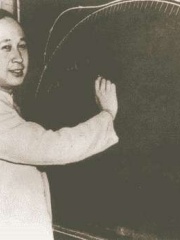
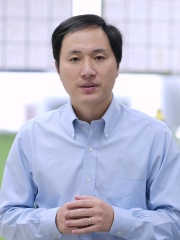
The Most Famous
PHYSICISTS from China
This page contains a list of the greatest Chinese Physicists. The pantheon dataset contains 851 Physicists, 7 of which were born in China. This makes China the birth place of the 18th most number of Physicists behind Canada, and Denmark.
Top 7
The following people are considered by Pantheon to be the most legendary Chinese Physicists of all time. This list of famous Chinese Physicists is sorted by HPI (Historical Popularity Index), a metric that aggregates information on a biography's online popularity.

1. Walter Houser Brattain (1902 - 1987)
With an HPI of 73.85, Walter Houser Brattain is the most famous Chinese Physicist. His biography has been translated into 75 different languages on wikipedia.
Walter Houser Brattain ( BRAT-n; February 10, 1902 – October 13, 1987) was an American solid-state physicist who shared the 1956 Nobel Prize in Physics with John Bardeen and William Shockley for their invention of the point-contact transistor. Brattain devoted much of his life to research on surface states.

2. Tsung-Dao Lee (1926 - 2024)
With an HPI of 70.51, Tsung-Dao Lee is the 2nd most famous Chinese Physicist. His biography has been translated into 73 different languages.
Tsung-Dao Lee (Chinese: 李政道; pinyin: Lǐ Zhèngdào; November 24, 1926 – August 4, 2024) was a Chinese-American physicist, known for his work on parity violation, the Lee–Yang theorem, particle physics, relativistic heavy ion (RHIC) physics, nontopological solitons, and soliton stars. He was a university professor emeritus at Columbia University in New York City, where he taught from 1953 until his retirement in 2012. In 1957, at the age of 30, Lee won the Nobel Prize in Physics with Chen Ning Yang for their work on the violation of the parity law in weak interactions, which Chien-Shiung Wu experimentally proved from 1956 to 1957, with her well known Wu experiment. Lee remains the youngest Nobel laureate in the science fields after World War II. He is the third-youngest Nobel laureate in sciences in history after William L. Bragg (who won the prize at 25 with his father William H. Bragg in 1915) and Werner Heisenberg (who won in 1932 also at 30). Lee and Yang were the first Chinese laureates. Since he became a naturalized American citizen in 1963, Lee is also the youngest American ever to have won a Nobel Prize.

3. Chien-Shiung Wu (1912 - 1997)
With an HPI of 69.53, Chien-Shiung Wu is the 3rd most famous Chinese Physicist. Her biography has been translated into 57 different languages.
Chien-Shiung Wu (Chinese: 吳健雄; pinyin: Wú Jiànxióng; Wade–Giles: Wu2 Chien4-Hsiung2; May 31, 1912 – February 16, 1997) was a Chinese-American particle and experimental physicist who made significant contributions in the fields of nuclear and particle physics. Wu worked on the Manhattan Project, where she helped develop the process for separating uranium into uranium-235 and uranium-238 isotopes by gaseous diffusion. She is best known for conducting the Wu experiment, which proved that parity is not conserved. This discovery resulted in her colleagues Tsung-Dao Lee and Chen-Ning Yang winning the 1957 Nobel Prize in Physics, while Wu herself was awarded the inaugural Wolf Prize in Physics in 1978. Her expertise in experimental physics evoked comparisons to Marie Curie. Her nicknames include the "First Lady of Physics", the "Chinese Marie Curie" and the "Queen of Nuclear Research".

4. Yang Chen-Ning (1922 - 2025)
With an HPI of 68.98, Yang Chen-Ning is the 4th most famous Chinese Physicist. His biography has been translated into 77 different languages.
Yang Chen-Ning (simplified Chinese: 杨振宁; traditional Chinese: 楊振寧; pinyin: Yáng Zhènníng; (1 October 1922 – 18 October 2025); also known as C. N. Yang, Yang Zhenning, or Franklin Yang) was a Chinese-American theoretical physicist who made significant contributions to statistical mechanics, integrable systems, gauge theory, particle physics and condensed matter physics. Yang is known for his collaboration with Robert Mills in 1954 in developing non-abelian gauge theory, widely known as the Yang–Mills theory, which describes the nuclear forces in the Standard Model of particle physics. Yang and Tsung-Dao Lee received the 1957 Nobel Prize in Physics for their work on parity non-conservation of the weak interaction, which was confirmed by the Wu experiment in 1956. The two proposed that the conservation of parity, a physical law observed to hold in all other physical processes, is violated in weak nuclear reactions – those nuclear processes that result in the emission of beta or alpha particles.
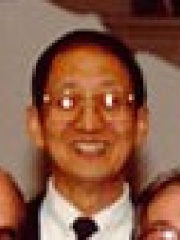
5. Daniel C. Tsui (b. 1939)
With an HPI of 67.22, Daniel C. Tsui is the 5th most famous Chinese Physicist. His biography has been translated into 62 different languages.
Daniel Chee Tsui (Chinese: 崔琦; pinyin: Cuī Qí, born February 28, 1939) is an American physicist. He is currently serving as the Professor of Electrical Engineering, emeritus, at Princeton University. Tsui's areas of research include electrical properties of thin films and microstructures of semiconductors and solid-state physics. Tsui won the Nobel Prize in Physics of 1998 with Robert B. Laughlin and Horst L. Störmer "for their discovery of a new form of quantum fluid with fractionally charged excitations."

6. Qian Xuesen (1911 - 2009)
With an HPI of 64.10, Qian Xuesen is the 6th most famous Chinese Physicist. His biography has been translated into 36 different languages.
Qian Xuesen (Chinese: 钱学森; December 11, 1911 – October 31, 2009; also spelled as Tsien Hsue-shen) was a Chinese aerospace engineer and cyberneticist who made significant contributions to the field of aerodynamics and established engineering cybernetics. He achieved recognition as one of America's leading experts in rockets and high-speed flight theory prior to his deportation to China in 1955. Qian received his undergraduate education in mechanical engineering at National Chiao Tung University in Shanghai in 1934. He traveled to the United States in 1935 and attained a master's degree in aeronautical engineering at the Massachusetts Institute of Technology in 1936. Afterward, he joined Theodore von Kármán's group at the California Institute of Technology in 1936, received a doctorate in aeronautics and mathematics there in 1939, and became an associate professor at Caltech in 1943. While at Caltech, he co-founded NASA's Jet Propulsion Laboratory. He was recruited by the United States Department of Defense and the Department of War to serve in various positions, including as an expert consultant with a rank of colonel in 1945. He became an associate professor at MIT in 1946, a full professor at MIT in 1947, and a full professor at Caltech in 1949. During the Second Red Scare in the 1950s, the United States federal government accused him of communist sympathies. In 1950, despite protests by his colleagues and without any evidence of the allegations, he was stripped of his security clearance. He was given a deferred deportation order by the Immigration and Naturalization Service, and for the following five years, he and his family were subjected to partial house arrest and government surveillance in an effort to gradually make his technical knowledge obsolete. After spending five years under house arrest, he was released in 1955 in exchange for the repatriation of American pilots who had been captured during the Korean War. He left the United States in September 1955 on the American President Lines passenger liner SS President Cleveland, arriving in mainland China via Hong Kong. Upon his return, he helped lead development of the Dongfeng ballistic missile and the Chinese space program. He also played a significant part in the construction and development of China's defense industry, higher education and research system, rocket force, and a key technology university. For his contributions, he became known as the "Father of Chinese Rocketry" and was nicknamed the "King of Rocketry". He is recognized as one of the founding fathers of Two Bombs, One Satellite. In 1957, Qian was elected an academician of the Chinese Academy of Sciences. He served as a Vice Chairman of the National Committee of the Chinese People's Political Consultative Conference from 1987 to 1998. He was the cousin of engineer Hsue-Chu Tsien, who was involved in the aerospace industries of both China and the United States. He is a cousin of the father of Roger Y. Tsien, the 2008 winner of the Nobel Prize in Chemistry.

7. He Jiankui (b. 1984)
With an HPI of 50.64, He Jiankui is the 7th most famous Chinese Physicist. His biography has been translated into 28 different languages.
He Jiankui (Chinese: 贺建奎; pinyin: Hè Jiànkuí [xɤ̂ tɕjɛ̂nkʰwěɪ] HUH JEE-enn KWAY; born 1984) is a Chinese biophysicist known for his controversial first use of genome editing in humans in 2018. He served as associate professor of biology at the Southern University of Science and Technology (SUSTech) in Shenzhen, Guangdong, China, before his dismissal from the university in January 2019. In November 2018, He announced that he had created the first human genetically edited babies, twin girls who were born modified with HIV resistance in October 2018 and were known by their pseudonyms, Lulu and Nana. The announcement was initially praised in the press as a major scientific advancement. However, following scrutiny on how the experiment was executed, he received widespread condemnation from the public and scientific community. An investigation report showed that he raised money for his research to evade government and university research regulations. His research activities were suspended by the Chinese authorities on 29 November 2018, and he was fired by SUSTech on 21 January 2019. On 30 December 2019, a Chinese district court found He Jiankui guilty of illegal practice of medicine (equivalent to the crime of "practicing medicine without a license" in many other jurisdictions), sentencing him to three years in prison with a fine of 3 million yuan. He was released from prison in April 2022. In February 2023, his application for a Hong Kong work visa was granted but was soon revoked after the Hong Kong Immigration Department launched a criminal investigation against him for making false statements in his application. In September 2023, He was recruited by the Wuchang University of Technology, a private college in Wuhan, Hubei, to serve as the inaugural director for the school's Genetic Medicine Institute. He was listed as one of Time's 100 most influential people of 2019, in the section "Pioneers". At the same time he was variously referred to as a "rogue scientist", "China's Dr. Frankenstein", and a "mad genius".
People
Pantheon has 7 people classified as Chinese physicists born between 1902 and 1984. Of these 7, 2 (28.57%) of them are still alive today. The most famous living Chinese physicists include Daniel C. Tsui, and He Jiankui. The most famous deceased Chinese physicists include Walter Houser Brattain, Tsung-Dao Lee, and Chien-Shiung Wu.
Living Chinese Physicists
Go to all RankingsDeceased Chinese Physicists
Go to all RankingsWalter Houser Brattain
1902 - 1987
HPI: 73.85
Tsung-Dao Lee
1926 - 2024
HPI: 70.51
Chien-Shiung Wu
1912 - 1997
HPI: 69.53
Yang Chen-Ning
1922 - 2025
HPI: 68.98
Qian Xuesen
1911 - 2009
HPI: 64.10
Overlapping Lives
Which Physicists were alive at the same time? This visualization shows the lifespans of the 5 most globally memorable Physicists since 1700.

